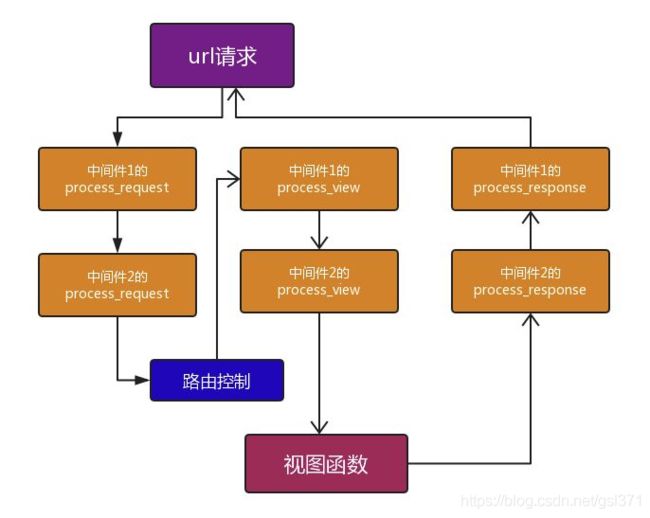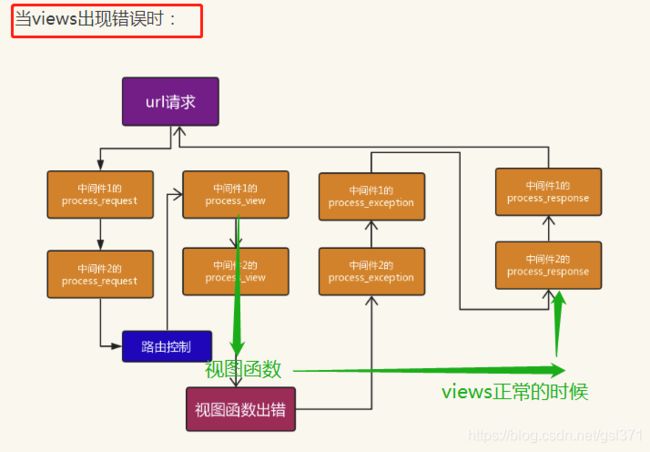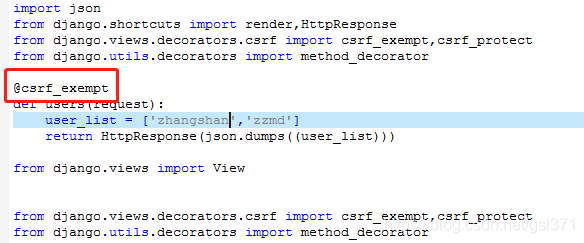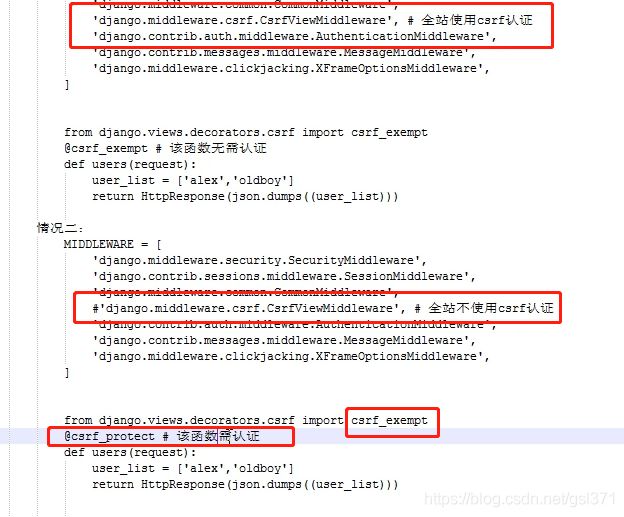drf框架
文章目录
- RESTful api接口规范
- 协议
- 域名
- api版本控制
- API 路径规则
- HTTP请求方式
- 过滤信息
- API 传入参数
- 返回数据
- 状态码
- 非Restful Api的需求
- 一致性原则
- 接口文档
- 中间件
- django中间件执行流程
- cbv加装饰器
- cbv加装饰器
- 基于Django实现
- 路由系统
- CBV视图
- 函数参数说明
- 打包参数(pack)
- 拆分参数(unpack)
- **kwargs
- 基于drt框架实现
- 基本流程
- 认证和授权
- 用户url传入的token认证
- 请求头认证
- 多个认证规则
- 认证和权限
- 全局使用
- 用户访问次数/频率限制
- 基于用户IP限制访问频率
- 基于用户IP显示访问频率(利于Django缓存)
- view中限制请求频率
- 匿名时用IP限制+登录时用Token限制
- 全局使用
- 版本
- 基于url的get传参方式
- 基于url的正则方式
- 基于 accept 请求头方式
- 基于主机名方法
- 基于django路由系统的namespace
- 全局使用
- 解析器(parser)
- 仅处理请求头content-type为application/json的请求体
- 仅处理请求头content-type为application/x-www-form-urlencoded 的请求体
- 仅处理请求头content-type为multipart/form-data的请求体
- 仅上传文件
- 同时多个Parser
- 全局使用
- 序列化
- 自定义字段
- 基于Model自动生成字段
- 生成URL
- 自动生成URL
转载原文链接
RESTful api接口规范
协议
API与用户的通信协议,总是使用HTTPs协议,确保交互数据的传输安全。
域名
应该尽量将API部署在专用域名之下。
https://api.example.com
如果确定API很简单,不会有进一步扩展,可以考虑放在主域名下。
https://example.org/api/
api版本控制
应该将API的版本号放入URL。
https://api.example.com/v{n}/
另一种做法是,将版本号放在HTTP头信息中,但不如放入URL方便和直观。Github采用这种做法。
采用多版本并存,增量发布的方式
v{n} n代表版本号,分为整形和浮点型
整形的版本号: 大功能版本发布形式;具有当前版本状态下的所有API接口 ,例如:v1,v2
浮点型:为小版本号,只具备补充api的功能,其他api都默认调用对应大版本号的api 例如:v1.1 v2.2
API 路径规则
路径又称"终点"(endpoint),表示API的具体网址。
在RESTful架构中,每个网址代表一种资源(resource),所以网址中不能有动词,只能有名词,而且所用的名词往往与数据库的表格名对应。一般来说,数据库中的表都是同种记录的"集合"(collection),所以API中的名词也应该使用复数。
https://api.example.com/v1/products
https://api.example.com/v1/users
https://api.example.com/v1/employees
HTTP请求方式
对于资源的具体操作类型,由HTTP动词表示。
常用的HTTP动词有下面四个(括号里是对应的SQL命令)。
增删改查 curd
GET(SELECT):从服务器取出资源(一项或多项)。
POST(CREATE):在服务器新建一个资源。
PUT(UPDATE):在服务器更新资源(客户端提供改变后的完整资源)。
DELETE(DELETE):从服务器删除资源。
下面是一些例子。
GET /product:列出所有商品
POST /product:新建一个商品
GET /product/ID:获取某个指定商品的信息
PUT /product/ID:更新某个指定商品的信息
DELETE /product/ID:删除某个商品
GET /product/ID/purchase :列出某个指定商品的所有投资者
get /product/ID/purchase/ID:获取某个指定商品的指定投资者信息
以前写增删改查需要写4个接口,restful规范的就是1个接口,根据method的不同做不同的操作,比如:get/post/delete/put/patch/delete.
过滤信息
如果记录数量很多,服务器不可能都将它们返回给用户。API应该提供分页参数及其它筛选参数数,过滤返回结果。
下面是一些常见的参数。
?limit=10:指定返回记录的数量
?offset=10:指定返回记录的开始位置。
?page=2&per_page=100:指定第几页,以及每页的记录数。
?sortby=name&order=asc:指定返回结果按照哪个属性排序,以及排序顺序。
?producy_type=1:指定筛选条件
API 传入参数
参入参数分为4种类型:
- 地址栏参数
restful 地址栏参数 /api/v1/product/122 122为产品编号,获取产品为122的信息
get方式的查询字串 见过滤信息小节
- 请求body数据
- cookie
- request header
cookie和header 一般都是用于OAuth认证的2种途径
返回数据
只要api接口成功接到请求,就不能返回200以外的HTTP状态。
为了保障前后端的数据交互的顺畅,建议规范数据的返回,并采用固定的数据格式封装。
接口返回模板:
response:
----------------------------------------
{
status: 200, // 详见【status】
data: {
code: 1, // 详见【code】
data: {} || [], // 数据
message: '成功', // 存放响应信息提示,显示给客户端用户【须语义化中文提示】
sysMessage: 'success' // 存放响应信息提示,调试使用,中英文都行
... // 其它参数,如 total【总记录数】等
},
msg: '成功', // 存放响应信息提示,显示给客户端用户【须语义化中文提示】
sysMsg: 'success' // 存放响应信息提示,调试使用,中英文都行
}
----------------------------------------
【status】:
200: OK 400: Bad Request 500:Internal Server Error
401:Unauthorized
403:Forbidden
404:Not Found
【code】:
1: 获取数据成功 | 操作成功 0:获取数据失败 | 操作失败
状态码
200 OK - [GET]:服务器成功返回用户请求的数据,该操作是幂等的(Idempotent)。
201 CREATED - [POST/PUT/PATCH]:用户新建或修改数据成功。
202 Accepted - [*]:表示一个请求已经进入后台排队(异步任务)
204 NO CONTENT - [DELETE]:用户删除数据成功。
400 INVALID REQUEST - [POST/PUT/PATCH]:用户发出的请求有错误,服务器没有进行新建或修改数据的操作,该操作是幂等的。
401 Unauthorized - [*]:表示用户没有权限(令牌、用户名、密码错误)。
403 Forbidden - [*] 表示用户得到授权(与401错误相对),但是访问是被禁止的。
404 NOT FOUND - [*]:用户发出的请求针对的是不存在的记录,服务器没有进行操作,该操作是幂等的。
406 Not Acceptable - [GET]:用户请求的格式不可得(比如用户请求JSON格式,但是只有XML格式)。
410 Gone -[GET]:用户请求的资源被永久删除,且不会再得到的。
422 Unprocesable entity - [POST/PUT/PATCH] 当创建一个对象时,发生一个验证错误。
500 INTERNAL SERVER ERROR - [*]:服务器发生错误,用户将无法判断发出的请求是否成功。
更多看这里:http://www.w3.org/Protocols/rfc2616/rfc2616-sec10.html
非Restful Api的需求
1、实际业务开展过程中,可能会出现各种的api不是简单的restful 规范能实现的。
2、需要有一些api突破restful规范原则。
3、特别是移动互联网的api设计,更需要有一些特定的api来优化数据请求的交互。
1)、删除单个 | 批量删除 : DELETE /v1/product body参数{ids:[]}
2)、页面级API : 把当前页面中需要用到的所有数据通过一个接口一次性返回全部数据
一致性原则
1、前端需要哪些字段,API接口应该返回哪些字段,字段不多也不少。
2、更新功能尽量做到:初次返回的原始数据参数与提交更新的数据参数结构一致。
3、时间参数,尽量以一致格式的字符串传递, 如:
‘2019-01’ | ‘2019/01’
‘2019-01-01’ | ‘2019/01/01’
‘2019-01-01 12:12:12’ | ‘2019/01/01 12:12:12’
4、其它参数【待更新】
接口文档
1、尽量采用自动化接口文档,可以做到在线测试,同步更新。
2、应包含:接口BASE地址、接口版本、接口模块分类等。
3、每个接口应包含:
接口地址:不包含接口BASE地址。
请求方式: get、post、put、delete等。
请求参数:数据格式【默认JSON、可选form data】、数据类型、是否必填、中文描述。
响应参数:类型、中文描述。
中间件
drt cbv执行流程
路由(url)->view()->dispatch()(反射执行其它get/post/delete/put方法。
django中间件执行流程
process_request
process_view
process_response
process_exception
process_render_template
- 权限
- 用户验证
- crsf token (在process_view中实现)
cbv加装饰器
cbv加装饰器
方法一:需要加在dispatch函数前,需要手工写个函数

方法二:
或者这种方法,指定类中方法名,加装饰器,可以不用写函数,直接用父类函数
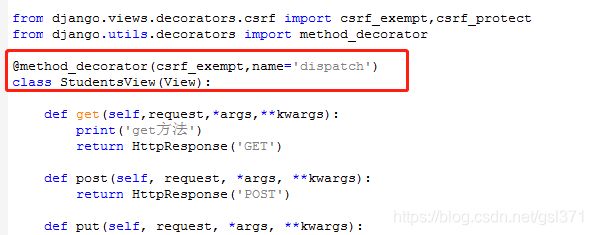
基于Django实现
路由系统
urls.py
urlpatterns = [
url(r'^users', Users.as_view()),
]
CBV视图
views.py
from django.views import View
from django.http import JsonResponse
class Users(View):
def get(self, request, *args, **kwargs):
result = {
'status': True,
'data': 'response data'
}
return JsonResponse(result, status=200)
def post(self, request, *args, **kwargs):
result = {
'status': True,
'data': 'response data'
}
return JsonResponse(result, status=200)
函数参数说明
和普通函数相比,在类中定义函数只有一点不同,就是第一参数永远是类的本身实例变量self,并且调用时,不用传递该参数。除此之外,类的方法(函数)和普通函数没啥区别,你既可以用默认参数、可变参数或者关键字参数(*args是可变参数,args接收的是一个tuple,**kw是关键字参数,kw接收的是一个dict)。
args有两部分构成为——∗和args。这里的重点是∗。
所以为了讲清楚args,我们要追根溯源——理解∗的作用。
这里敲黑板,重点来了:∗的作用,有2个—— 打包参数(pack)和拆分参数(unpack)!
打包参数(pack)
示例
def foo(*number):
print(number)
foo(1, 2, 3, 4, 5)
结果
(1, 2, 3, 4, 5)
我们看到了什么?给函数5个参数,成功运行了,而且输出是参数构成的元组。
我们知道,如果number前不加∗号,那么很明显foo()只能接受1个参数,参数给多了少了都要报错。而加上∗,就能成功运行。
那么原理是什么呢?
答案是:∗把函数foo()接受到的多个参数1,2,3,4,5,打包成了元组(1,2,3,4,5),赋值给了形参number。
def foo(a, *number):
print('a:', a)
print('number:', number)
for i in number:
print(i)
print(type(number))
foo(1, 2, 3, 4, 5)
a: 1
number (2, 3, 4, 5)
2
3
4
5
<class 'tuple'>
从例3可以看出,number接受到的实参变成了(2,3,4,5),第一个参数1被形参a接受走了。
所以这里我们可以给出∗作用的完整版:
∗的作用:函数接受实参时,按顺序分配给函数形参,如果遇到带∗的形参,那么就把还未分配出去的实参以元组形式打包(pack),分配给那个带∗的形参。
拆分参数(unpack)
def bar(a,b,c):
print(a,b,c)
bar(*[1,2,3])
结果
1 2 3
可以看出,∗这次没有用在函数定义中,而是用在了函数调用中。在本例中的作用是啥呢?
答案是:把打包了的实参(元组或列表),拆分(unpack)成单个的,依次赋值给函数的形参。
在本例中,打包了的实参[1,2,3]被拆分,1赋值给了形参a,2赋值给了形参b,3复制给了形参c。
**kwargs
上边*args学懂了,**kwargs也就很容易明白了。
**kwargs也有两部分构成为——∗∗和kwargs。这里的重点是∗∗。没错,kwargs仅仅是一个约定俗成的写法,没有其他特殊含义,换成其他的也照用不误,但是为了代码可读性,最好还是用约定俗成的。
∗∗的作用同样也有两个—— 打包参数(pack)和拆分参数(unpack)!
但是区别还是有的,简单来说就是:
打包(pack):*args是把多个位置参数打包成元组,**kwargs是把多个关键字参数打包成字典。
拆分(unpack):*args是把打包了的参数拆成单个的,依次赋值给函数的形参,**kwargs是把字典的键值拆成单个的,依次赋值给函数的形参。
>>> def bar(**number):
... print(number)
...
>>>
>>> bar(a=1, b=2, c=3)
{'a': 1, 'b': 2, 'c': 3}
>>>
>>> def bar(a, b, c):
... print(a,b,c)
...
>>>
>>> bar(**{'a': 1, 'b': 2, 'c': 3})
1 2 3
>>>
基于drt框架实现
基本流程
urls.py
from django.conf.urls import url, include
from web.views.s1_api import TestView
urlpatterns = [
url(r'^test/', TestView.as_view()),
]
views.py
from rest_framework.views import APIView
from rest_framework.response import Response
class TestView(APIView):
def dispatch(self, request, *args, **kwargs):
"""
请求到来之后,都要执行dispatch方法,dispatch方法根据请求方式不同触发 get/post/put等方法
注意:APIView中的dispatch方法有好多好多的功能
"""
return super().dispatch(request, *args, **kwargs)
def get(self, request, *args, **kwargs):
return Response('GET请求,响应内容')
def post(self, request, *args, **kwargs):
return Response('POST请求,响应内容')
def put(self, request, *args, **kwargs):
return Response('PUT请求,响应内容')
上述是rest framework框架基本流程,重要的功能是在APIView的dispatch中触发。
认证和授权
用户url传入的token认证
urls.py
from django.conf.urls import url, include
from web.viewsimport TestView
urlpatterns = [
url(r'^test/', TestView.as_view()),
]
views.py
from rest_framework.views import APIView
from rest_framework.response import Response
from rest_framework.authentication import BaseAuthentication
from rest_framework.request import Request
from rest_framework import exceptions
token_list = [
'sfsfss123kuf3j123',
'asijnfowerkkf9812',
]
class TestAuthentication(BaseAuthentication):
def authenticate(self, request):
"""
用户认证,如果验证成功后返回元组: (用户,用户Token)
:param request:
:return:
None,表示跳过该验证;
如果跳过了所有认证,默认用户和Token和使用配置文件进行设置
self._authenticator = None
if api_settings.UNAUTHENTICATED_USER:
self.user = api_settings.UNAUTHENTICATED_USER()
else:
self.user = None
if api_settings.UNAUTHENTICATED_TOKEN:
self.auth = api_settings.UNAUTHENTICATED_TOKEN()
else:
self.auth = None
(user,token)表示验证通过并设置用户名和Token;
AuthenticationFailed异常
"""
val = request.query_params.get('token')
if val not in token_list:
raise exceptions.AuthenticationFailed("用户认证失败")
return ('登录用户', '用户token')
def authenticate_header(self, request):
"""
Return a string to be used as the value of the `WWW-Authenticate`
header in a `401 Unauthenticated` response, or `None` if the
authentication scheme should return `403 Permission Denied` responses.
"""
# 验证失败时,返回的响应头WWW-Authenticate对应的值
pass
class TestView(APIView):
authentication_classes = [TestAuthentication, ]
permission_classes = []
def get(self, request, *args, **kwargs):
print(request.user)
print(request.auth)
return Response('GET请求,响应内容')
def post(self, request, *args, **kwargs):
return Response('POST请求,响应内容')
def put(self, request, *args, **kwargs):
return Response('PUT请求,响应内容')
请求头认证
urls.py
from django.conf.urls import url, include
from web.viewsimport TestView
urlpatterns = [
url(r'^test/', TestView.as_view()),
]
views.py
from rest_framework.views import APIView
from rest_framework.response import Response
from rest_framework.authentication import BaseAuthentication
from rest_framework.request import Request
from rest_framework import exceptions
token_list = [
'sfsfss123kuf3j123',
'asijnfowerkkf9812',
]
class TestAuthentication(BaseAuthentication):
def authenticate(self, request):
"""
用户认证,如果验证成功后返回元组: (用户,用户Token)
:param request:
:return:
None,表示跳过该验证;
如果跳过了所有认证,默认用户和Token和使用配置文件进行设置
self._authenticator = None
if api_settings.UNAUTHENTICATED_USER:
self.user = api_settings.UNAUTHENTICATED_USER()
else:
self.user = None
if api_settings.UNAUTHENTICATED_TOKEN:
self.auth = api_settings.UNAUTHENTICATED_TOKEN()
else:
self.auth = None
(user,token)表示验证通过并设置用户名和Token;
AuthenticationFailed异常
"""
import base64
auth = request.META.get('HTTP_AUTHORIZATION', b'')
if auth:
auth = auth.encode('utf-8')
auth = auth.split()
if not auth or auth[0].lower() != b'basic':
raise exceptions.AuthenticationFailed('验证失败')
if len(auth) != 2:
raise exceptions.AuthenticationFailed('验证失败')
username, part, password = base64.b64decode(auth[1]).decode('utf-8').partition(':')
if username == 'alex' and password == '123':
return ('登录用户', '用户token')
else:
raise exceptions.AuthenticationFailed('用户名或密码错误')
def authenticate_header(self, request):
"""
Return a string to be used as the value of the `WWW-Authenticate`
header in a `401 Unauthenticated` response, or `None` if the
authentication scheme should return `403 Permission Denied` responses.
"""
return 'Basic realm=api'
class TestView(APIView):
authentication_classes = [TestAuthentication, ]
permission_classes = []
def get(self, request, *args, **kwargs):
print(request.user)
print(request.auth)
return Response('GET请求,响应内容')
def post(self, request, *args, **kwargs):
return Response('POST请求,响应内容')
def put(self, request, *args, **kwargs):
return Response('PUT请求,响应内容')
多个认证规则
urls.py
from django.conf.urls import url, include
from web.views.s2_auth import TestView
urlpatterns = [
url(r'^test/', TestView.as_view()),
]
views.py
from rest_framework.views import APIView
from rest_framework.response import Response
from rest_framework.authentication import BaseAuthentication
from rest_framework.request import Request
from rest_framework import exceptions
token_list = [
'sfsfss123kuf3j123',
'asijnfowerkkf9812',
]
class Test1Authentication(BaseAuthentication):
def authenticate(self, request):
"""
用户认证,如果验证成功后返回元组: (用户,用户Token)
:param request:
:return:
None,表示跳过该验证;
如果跳过了所有认证,默认用户和Token和使用配置文件进行设置
self._authenticator = None
if api_settings.UNAUTHENTICATED_USER:
self.user = api_settings.UNAUTHENTICATED_USER() # 默认值为:匿名用户
else:
self.user = None
if api_settings.UNAUTHENTICATED_TOKEN:
self.auth = api_settings.UNAUTHENTICATED_TOKEN()# 默认值为:None
else:
self.auth = None
(user,token)表示验证通过并设置用户名和Token;
AuthenticationFailed异常
"""
import base64
auth = request.META.get('HTTP_AUTHORIZATION', b'')
if auth:
auth = auth.encode('utf-8')
else:
return None
print(auth,'xxxx')
auth = auth.split()
if not auth or auth[0].lower() != b'basic':
raise exceptions.AuthenticationFailed('验证失败')
if len(auth) != 2:
raise exceptions.AuthenticationFailed('验证失败')
username, part, password = base64.b64decode(auth[1]).decode('utf-8').partition(':')
if username == 'alex' and password == '123':
return ('登录用户', '用户token')
else:
raise exceptions.AuthenticationFailed('用户名或密码错误')
def authenticate_header(self, request):
"""
Return a string to be used as the value of the `WWW-Authenticate`
header in a `401 Unauthenticated` response, or `None` if the
authentication scheme should return `403 Permission Denied` responses.
"""
# return 'Basic realm=api'
pass
class Test2Authentication(BaseAuthentication):
def authenticate(self, request):
"""
用户认证,如果验证成功后返回元组: (用户,用户Token)
:param request:
:return:
None,表示跳过该验证;
如果跳过了所有认证,默认用户和Token和使用配置文件进行设置
self._authenticator = None
if api_settings.UNAUTHENTICATED_USER:
self.user = api_settings.UNAUTHENTICATED_USER() # 默认值为:匿名用户
else:
self.user = None
if api_settings.UNAUTHENTICATED_TOKEN:
self.auth = api_settings.UNAUTHENTICATED_TOKEN()# 默认值为:None
else:
self.auth = None
(user,token)表示验证通过并设置用户名和Token;
AuthenticationFailed异常
"""
val = request.query_params.get('token')
if val not in token_list:
raise exceptions.AuthenticationFailed("用户认证失败")
return ('登录用户', '用户token')
def authenticate_header(self, request):
"""
Return a string to be used as the value of the `WWW-Authenticate`
header in a `401 Unauthenticated` response, or `None` if the
authentication scheme should return `403 Permission Denied` responses.
"""
pass
class TestView(APIView):
authentication_classes = [Test1Authentication, Test2Authentication]
permission_classes = []
def get(self, request, *args, **kwargs):
print(request.user)
print(request.auth)
return Response('GET请求,响应内容')
def post(self, request, *args, **kwargs):
return Response('POST请求,响应内容')
def put(self, request, *args, **kwargs):
return Response('PUT请求,响应内容')
认证和权限
urls.py
from django.conf.urls import url, include
from web.views import TestView
urlpatterns = [
url(r'^test/', TestView.as_view()),
]
views.py
from rest_framework.views import APIView
from rest_framework.response import Response
from rest_framework.authentication import BaseAuthentication
from rest_framework.permissions import BasePermission
from rest_framework.request import Request
from rest_framework import exceptions
token_list = [
'sfsfss123kuf3j123',
'asijnfowerkkf9812',
]
class TestAuthentication(BaseAuthentication):
def authenticate(self, request):
"""
用户认证,如果验证成功后返回元组: (用户,用户Token)
:param request:
:return:
None,表示跳过该验证;
如果跳过了所有认证,默认用户和Token和使用配置文件进行设置
self._authenticator = None
if api_settings.UNAUTHENTICATED_USER:
self.user = api_settings.UNAUTHENTICATED_USER() # 默认值为:匿名用户
else:
self.user = None
if api_settings.UNAUTHENTICATED_TOKEN:
self.auth = api_settings.UNAUTHENTICATED_TOKEN()# 默认值为:None
else:
self.auth = None
(user,token)表示验证通过并设置用户名和Token;
AuthenticationFailed异常
"""
val = request.query_params.get('token')
if val not in token_list:
raise exceptions.AuthenticationFailed("用户认证失败")
return ('登录用户', '用户token')
def authenticate_header(self, request):
"""
Return a string to be used as the value of the `WWW-Authenticate`
header in a `401 Unauthenticated` response, or `None` if the
authentication scheme should return `403 Permission Denied` responses.
"""
pass
class TestPermission(BasePermission):
message = "权限验证失败"
def has_permission(self, request, view):
"""
判断是否有权限访问当前请求
Return `True` if permission is granted, `False` otherwise.
:param request:
:param view:
:return: True有权限;False无权限
"""
if request.user == "管理员":
return True
# GenericAPIView中get_object时调用
def has_object_permission(self, request, view, obj):
"""
视图继承GenericAPIView,并在其中使用get_object时获取对象时,触发单独对象权限验证
Return `True` if permission is granted, `False` otherwise.
:param request:
:param view:
:param obj:
:return: True有权限;False无权限
"""
if request.user == "管理员":
return True
class TestView(APIView):
# 认证的动作是由request.user触发
authentication_classes = [TestAuthentication, ]
# 权限
# 循环执行所有的权限
permission_classes = [TestPermission, ]
def get(self, request, *args, **kwargs):
# self.dispatch
print(request.user)
print(request.auth)
return Response('GET请求,响应内容')
def post(self, request, *args, **kwargs):
return Response('POST请求,响应内容')
def put(self, request, *args, **kwargs):
return Response('PUT请求,响应内容')
全局使用
上述操作中均是对单独视图进行特殊配置,如果想要对全局进行配置,则需要再配置文件中写入即可。
settings.py
REST_FRAMEWORK = {
'UNAUTHENTICATED_USER': None,
'UNAUTHENTICATED_TOKEN': None,
"DEFAULT_AUTHENTICATION_CLASSES": [
"web.utils.TestAuthentication",
],
"DEFAULT_PERMISSION_CLASSES": [
"web.utils.TestPermission",
],
}
urls.py
from django.conf.urls import url, include
from web.views import TestView
urlpatterns = [
url(r'^test/', TestView.as_view()),
]
views.py
from rest_framework.views import APIView
from rest_framework.response import Response
class TestView(APIView):
def get(self, request, *args, **kwargs):
# self.dispatch
print(request.user)
print(request.auth)
return Response('GET请求,响应内容')
def post(self, request, *args, **kwargs):
return Response('POST请求,响应内容')
def put(self, request, *args, **kwargs):
return Response('PUT请求,响应内容')
用户访问次数/频率限制
基于用户IP限制访问频率
from django.conf.urls import url, include
from web.views import TestView
urlpatterns = [
url(r'^test/', TestView.as_view()),
]
urls.py
#!/usr/bin/env python
# -*- coding:utf-8 -*-
import time
from rest_framework.views import APIView
from rest_framework.response import Response
from rest_framework import exceptions
from rest_framework.throttling import BaseThrottle
from rest_framework.settings import api_settings
# 保存访问记录
RECORD = {
'用户IP': [12312139, 12312135, 12312133, ]
}
class TestThrottle(BaseThrottle):
ctime = time.time
def get_ident(self, request):
"""
根据用户IP和代理IP,当做请求者的唯一IP
Identify the machine making the request by parsing HTTP_X_FORWARDED_FOR
if present and number of proxies is > 0. If not use all of
HTTP_X_FORWARDED_FOR if it is available, if not use REMOTE_ADDR.
"""
xff = request.META.get('HTTP_X_FORWARDED_FOR')
remote_addr = request.META.get('REMOTE_ADDR')
num_proxies = api_settings.NUM_PROXIES
if num_proxies is not None:
if num_proxies == 0 or xff is None:
return remote_addr
addrs = xff.split(',')
client_addr = addrs[-min(num_proxies, len(addrs))]
return client_addr.strip()
return ''.join(xff.split()) if xff else remote_addr
def allow_request(self, request, view):
"""
是否仍然在允许范围内
Return `True` if the request should be allowed, `False` otherwise.
:param request:
:param view:
:return: True,表示可以通过;False表示已超过限制,不允许访问
"""
# 获取用户唯一标识(如:IP)
# 允许一分钟访问10次
num_request = 10
time_request = 60
now = self.ctime()
ident = self.get_ident(request)
self.ident = ident
if ident not in RECORD:
RECORD[ident] = [now, ]
return True
history = RECORD[ident]
while history and history[-1] <= now - time_request:
history.pop()
if len(history) < num_request:
history.insert(0, now)
return True
def wait(self):
"""
多少秒后可以允许继续访问
Optionally, return a recommended number of seconds to wait before
the next request.
"""
last_time = RECORD[self.ident][0]
now = self.ctime()
return int(60 + last_time - now)
class TestView(APIView):
throttle_classes = [TestThrottle, ]
def get(self, request, *args, **kwargs):
# self.dispatch
print(request.user)
print(request.auth)
return Response('GET请求,响应内容')
def post(self, request, *args, **kwargs):
return Response('POST请求,响应内容')
def put(self, request, *args, **kwargs):
return Response('PUT请求,响应内容')
def throttled(self, request, wait):
"""
访问次数被限制时,定制错误信息
"""
class Throttled(exceptions.Throttled):
default_detail = '请求被限制.'
extra_detail_singular = '请 {wait} 秒之后再重试.'
extra_detail_plural = '请 {wait} 秒之后再重试.'
raise Throttled(wait)
views.py
基于用户IP显示访问频率(利于Django缓存)
REST_FRAMEWORK = {
'DEFAULT_THROTTLE_RATES': {
'test_scope': '10/m',
},
}
from django.conf.urls import url, include
from web.views import TestView
urlpatterns = [
url(r'^test/', TestView.as_view()),
]
urls.py
from rest_framework.views import APIView
from rest_framework.response import Response
from rest_framework import exceptions
from rest_framework.throttling import SimpleRateThrottle
class TestThrottle(SimpleRateThrottle):
# 配置文件定义的显示频率的Key
scope = "test_scope"
def get_cache_key(self, request, view):
"""
Should return a unique cache-key which can be used for throttling.
Must be overridden.
May return `None` if the request should not be throttled.
"""
if not request.user:
ident = self.get_ident(request)
else:
ident = request.user
return self.cache_format % {
'scope': self.scope,
'ident': ident
}
class TestView(APIView):
throttle_classes = [TestThrottle, ]
def get(self, request, *args, **kwargs):
# self.dispatch
print(request.user)
print(request.auth)
return Response('GET请求,响应内容')
def post(self, request, *args, **kwargs):
return Response('POST请求,响应内容')
def put(self, request, *args, **kwargs):
return Response('PUT请求,响应内容')
def throttled(self, request, wait):
"""
访问次数被限制时,定制错误信息
"""
class Throttled(exceptions.Throttled):
default_detail = '请求被限制.'
extra_detail_singular = '请 {wait} 秒之后再重试.'
extra_detail_plural = '请 {wait} 秒之后再重试.'
raise Throttled(wait)
views.py
view中限制请求频率
REST_FRAMEWORK = {
'DEFAULT_THROTTLE_RATES': {
'xxxxxx': '10/m',
},
from django.conf.urls import url, include
from web.views import TestView
urlpatterns = [
url(r'^test/', TestView.as_view()),
]
urls.py
#!/usr/bin/env python
# -*- coding:utf-8 -*-
from rest_framework.views import APIView
from rest_framework.response import Response
from rest_framework import exceptions
from rest_framework.throttling import ScopedRateThrottle
# 继承 ScopedRateThrottle
class TestThrottle(ScopedRateThrottle):
def get_cache_key(self, request, view):
"""
Should return a unique cache-key which can be used for throttling.
Must be overridden.
May return `None` if the request should not be throttled.
"""
if not request.user:
ident = self.get_ident(request)
else:
ident = request.user
return self.cache_format % {
'scope': self.scope,
'ident': ident
}
class TestView(APIView):
throttle_classes = [TestThrottle, ]
# 在settings中获取 xxxxxx 对应的频率限制值
throttle_scope = "xxxxxx"
def get(self, request, *args, **kwargs):
# self.dispatch
print(request.user)
print(request.auth)
return Response('GET请求,响应内容')
def post(self, request, *args, **kwargs):
return Response('POST请求,响应内容')
def put(self, request, *args, **kwargs):
return Response('PUT请求,响应内容')
def throttled(self, request, wait):
"""
访问次数被限制时,定制错误信息
"""
class Throttled(exceptions.Throttled):
default_detail = '请求被限制.'
extra_detail_singular = '请 {wait} 秒之后再重试.'
extra_detail_plural = '请 {wait} 秒之后再重试.'
raise Throttled(wait)
views.py
匿名时用IP限制+登录时用Token限制
REST_FRAMEWORK = {
'UNAUTHENTICATED_USER': None,
'UNAUTHENTICATED_TOKEN': None,
'DEFAULT_THROTTLE_RATES': {
'luffy_anon': '10/m',
'luffy_user': '20/m',
},
}
settings.py
from django.conf.urls import url, include
from web.views.s3_throttling import TestView
urlpatterns = [
url(r'^test/', TestView.as_view()),
]
urls.py
#!/usr/bin/env python
# -*- coding:utf-8 -*-
from rest_framework.views import APIView
from rest_framework.response import Response
from rest_framework.throttling import SimpleRateThrottle
class LuffyAnonRateThrottle(SimpleRateThrottle):
"""
匿名用户,根据IP进行限制
"""
scope = "luffy_anon"
def get_cache_key(self, request, view):
# 用户已登录,则跳过 匿名频率限制
if request.user:
return None
return self.cache_format % {
'scope': self.scope,
'ident': self.get_ident(request)
}
class LuffyUserRateThrottle(SimpleRateThrottle):
"""
登录用户,根据用户token限制
"""
scope = "luffy_user"
def get_ident(self, request):
"""
认证成功时:request.user是用户对象;request.auth是token对象
:param request:
:return:
"""
# return request.auth.token
return "user_token"
def get_cache_key(self, request, view):
"""
获取缓存key
:param request:
:param view:
:return:
"""
# 未登录用户,则跳过 Token限制
if not request.user:
return None
return self.cache_format % {
'scope': self.scope,
'ident': self.get_ident(request)
}
class TestView(APIView):
throttle_classes = [LuffyUserRateThrottle, LuffyAnonRateThrottle, ]
def get(self, request, *args, **kwargs):
# self.dispatch
print(request.user)
print(request.auth)
return Response('GET请求,响应内容')
def post(self, request, *args, **kwargs):
return Response('POST请求,响应内容')
def put(self, request, *args, **kwargs):
return Response('PUT请求,响应内容')
views.py
全局使用
REST_FRAMEWORK = {
'DEFAULT_THROTTLE_CLASSES': [
'api.utils.throttles.throttles.LuffyAnonRateThrottle',
'api.utils.throttles.throttles.LuffyUserRateThrottle',
],
'DEFAULT_THROTTLE_RATES': {
'anon': '10/day',
'user': '10/day',
'luffy_anon': '10/m',
'luffy_user': '20/m',
},
}
settings
版本
基于url的get传参方式
如:/users?version=v1
REST_FRAMEWORK = {
'DEFAULT_VERSION': 'v1', # 默认版本
'ALLOWED_VERSIONS': ['v1', 'v2'], # 允许的版本
'VERSION_PARAM': 'version' # URL中获取值的key
}
from django.conf.urls import url, include
from web.views import TestView
urlpatterns = [
url(r'^test/', TestView.as_view(),name='test'),
]
urls.py
#!/usr/bin/env python
# -*- coding:utf-8 -*-
from rest_framework.views import APIView
from rest_framework.response import Response
from rest_framework.versioning import QueryParameterVersioning
class TestView(APIView):
versioning_class = QueryParameterVersioning
def get(self, request, *args, **kwargs):
# 获取版本
print(request.version)
# 获取版本管理的类
print(request.versioning_scheme)
# 反向生成URL
reverse_url = request.versioning_scheme.reverse('test', request=request)
print(reverse_url)
return Response('GET请求,响应内容')
def post(self, request, *args, **kwargs):
return Response('POST请求,响应内容')
def put(self, request, *args, **kwargs):
return Response('PUT请求,响应内容')
views.py
基于url的正则方式
如:/v1/users/
REST_FRAMEWORK = {
'DEFAULT_VERSION': 'v1', # 默认版本
'ALLOWED_VERSIONS': ['v1', 'v2'], # 允许的版本
'VERSION_PARAM': 'version' # URL中获取值的key
}
from django.conf.urls import url, include
from web.views import TestView
urlpatterns = [
url(r'^(?P[v1|v2]+)/test/' , TestView.as_view(), name='test'),
]
urls.py
#!/usr/bin/env python
# -*- coding:utf-8 -*-
from rest_framework.views import APIView
from rest_framework.response import Response
from rest_framework.versioning import URLPathVersioning
class TestView(APIView):
versioning_class = URLPathVersioning
def get(self, request, *args, **kwargs):
# 获取版本
print(request.version)
# 获取版本管理的类
print(request.versioning_scheme)
# 反向生成URL
reverse_url = request.versioning_scheme.reverse('test', request=request)
print(reverse_url)
return Response('GET请求,响应内容')
def post(self, request, *args, **kwargs):
return Response('POST请求,响应内容')
def put(self, request, *args, **kwargs):
return Response('PUT请求,响应内容')
views.py
基于 accept 请求头方式
如:Accept: application/json; version=1.0
REST_FRAMEWORK = {
'DEFAULT_VERSION': 'v1', # 默认版本
'ALLOWED_VERSIONS': ['v1', 'v2'], # 允许的版本
'VERSION_PARAM': 'version' # URL中获取值的key
}
from django.conf.urls import url, include
from web.views import TestView
urlpatterns = [
url(r'^test/', TestView.as_view(), name='test'),
]
urls.py
#!/usr/bin/env python
# -*- coding:utf-8 -*-
from rest_framework.views import APIView
from rest_framework.response import Response
from rest_framework.versioning import AcceptHeaderVersioning
class TestView(APIView):
versioning_class = AcceptHeaderVersioning
def get(self, request, *args, **kwargs):
# 获取版本 HTTP_ACCEPT头
print(request.version)
# 获取版本管理的类
print(request.versioning_scheme)
# 反向生成URL
reverse_url = request.versioning_scheme.reverse('test', request=request)
print(reverse_url)
return Response('GET请求,响应内容')
def post(self, request, *args, **kwargs):
return Response('POST请求,响应内容')
def put(self, request, *args, **kwargs):
return Response('PUT请求,响应内容')
views.py
基于主机名方法
如:v1.example.com
ALLOWED_HOSTS = ['*']
REST_FRAMEWORK = {
'DEFAULT_VERSION': 'v1', # 默认版本
'ALLOWED_VERSIONS': ['v1', 'v2'], # 允许的版本
'VERSION_PARAM': 'version' # URL中获取值的key
}
settings.py
from django.conf.urls import url, include
from web.views import TestView
urlpatterns = [
url(r'^test/', TestView.as_view(), name='test'),
]
urls.py
#!/usr/bin/env python
# -*- coding:utf-8 -*-
from rest_framework.views import APIView
from rest_framework.response import Response
from rest_framework.versioning import HostNameVersioning
class TestView(APIView):
versioning_class = HostNameVersioning
def get(self, request, *args, **kwargs):
# 获取版本
print(request.version)
# 获取版本管理的类
print(request.versioning_scheme)
# 反向生成URL
reverse_url = request.versioning_scheme.reverse('test', request=request)
print(reverse_url)
return Response('GET请求,响应内容')
def post(self, request, *args, **kwargs):
return Response('POST请求,响应内容')
def put(self, request, *args, **kwargs):
return Response('PUT请求,响应内容')
views.py
基于django路由系统的namespace
如:example.com/v1/users/
REST_FRAMEWORK = {
'DEFAULT_VERSION': 'v1', # 默认版本
'ALLOWED_VERSIONS': ['v1', 'v2'], # 允许的版本
'VERSION_PARAM': 'version' # URL中获取值的key
}
from django.conf.urls import url, include
from web.views import TestView
urlpatterns = [
url(r'^v1/', ([
url(r'test/', TestView.as_view(), name='test'),
], None, 'v1')),
url(r'^v2/', ([
url(r'test/', TestView.as_view(), name='test'),
], None, 'v2')),
]
urls.py
#!/usr/bin/env python
# -*- coding:utf-8 -*-
from rest_framework.views import APIView
from rest_framework.response import Response
from rest_framework.versioning import NamespaceVersioning
class TestView(APIView):
versioning_class = NamespaceVersioning
def get(self, request, *args, **kwargs):
# 获取版本
print(request.version)
# 获取版本管理的类
print(request.versioning_scheme)
# 反向生成URL
reverse_url = request.versioning_scheme.reverse('test', request=request)
print(reverse_url)
return Response('GET请求,响应内容')
def post(self, request, *args, **kwargs):
return Response('POST请求,响应内容')
def put(self, request, *args, **kwargs):
return Response('PUT请求,响应内容')
views.py
全局使用
REST_FRAMEWORK = {
'DEFAULT_VERSIONING_CLASS':"rest_framework.versioning.URLPathVersioning",
'DEFAULT_VERSION': 'v1',
'ALLOWED_VERSIONS': ['v1', 'v2'],
'VERSION_PARAM': 'version'
}
settings.py
解析器(parser)
根据请求头 content-type 选择对应的解析器就请求体内容进行处理。
仅处理请求头content-type为application/json的请求体
from django.conf.urls import url, include
from web.views.s5_parser import TestView
urlpatterns = [
url(r'test/', TestView.as_view(), name='test'),
]
urls.py
#!/usr/bin/env python
# -*- coding:utf-8 -*-
from rest_framework.views import APIView
from rest_framework.response import Response
from rest_framework.request import Request
from rest_framework.parsers import JSONParser
class TestView(APIView):
parser_classes = [JSONParser, ]
def post(self, request, *args, **kwargs):
print(request.content_type)
# 获取请求的值,并使用对应的JSONParser进行处理
print(request.data)
# application/x-www-form-urlencoded 或 multipart/form-data时,request.POST中才有值
print(request.POST)
print(request.FILES)
return Response('POST请求,响应内容')
def put(self, request, *args, **kwargs):
return Response('PUT请求,响应内容')
views.py
仅处理请求头content-type为application/x-www-form-urlencoded 的请求体
from django.conf.urls import url, include
from web.views import TestView
urlpatterns = [
url(r'test/', TestView.as_view(), name='test'),
]
urls.py
#!/usr/bin/env python
# -*- coding:utf-8 -*-
from rest_framework.views import APIView
from rest_framework.response import Response
from rest_framework.request import Request
from rest_framework.parsers import FormParser
class TestView(APIView):
parser_classes = [FormParser, ]
def post(self, request, *args, **kwargs):
print(request.content_type)
# 获取请求的值,并使用对应的JSONParser进行处理
print(request.data)
# application/x-www-form-urlencoded 或 multipart/form-data时,request.POST中才有值
print(request.POST)
print(request.FILES)
return Response('POST请求,响应内容')
def put(self, request, *args, **kwargs):
return Response('PUT请求,响应内容')
views.py
仅处理请求头content-type为multipart/form-data的请求体
from django.conf.urls import url, include
from web.views import TestView
urlpatterns = [
url(r'test/', TestView.as_view(), name='test'),
]
urls.py
#!/usr/bin/env python
# -*- coding:utf-8 -*-
from rest_framework.views import APIView
from rest_framework.response import Response
from rest_framework.request import Request
from rest_framework.parsers import MultiPartParser
class TestView(APIView):
parser_classes = [MultiPartParser, ]
def post(self, request, *args, **kwargs):
print(request.content_type)
# 获取请求的值,并使用对应的JSONParser进行处理
print(request.data)
# application/x-www-form-urlencoded 或 multipart/form-data时,request.POST中才有值
print(request.POST)
print(request.FILES)
return Response('POST请求,响应内容')
def put(self, request, *args, **kwargs):
return Response('PUT请求,响应内容')
views.py
<!DOCTYPE html>
<html lang="en">
<head>
<meta charset="UTF-8">
<title>Title</title>
</head>
<body>
<form action="http://127.0.0.1:8000/test/" method="post" enctype="multipart/form-data">
<input type="text" name="user" />
<input type="file" name="img">
<input type="submit" value="提交">
</form>
</body>
</html>
upload.html
仅上传文件
from django.conf.urls import url, include
from web.views import TestView
urlpatterns = [
url(r'test/(?P[^/]+)' , TestView.as_view(), name='test'),
]
urls.py
#!/usr/bin/env python
# -*- coding:utf-8 -*-
from rest_framework.views import APIView
from rest_framework.response import Response
from rest_framework.request import Request
from rest_framework.parsers import FileUploadParser
class TestView(APIView):
parser_classes = [FileUploadParser, ]
def post(self, request, filename, *args, **kwargs):
print(filename)
print(request.content_type)
# 获取请求的值,并使用对应的JSONParser进行处理
print(request.data)
# application/x-www-form-urlencoded 或 multipart/form-data时,request.POST中才有值
print(request.POST)
print(request.FILES)
return Response('POST请求,响应内容')
def put(self, request, *args, **kwargs):
return Response('PUT请求,响应内容')
views.py
<!DOCTYPE html>
<html lang="en">
<head>
<meta charset="UTF-8">
<title>Title</title>
</head>
<body>
<form action="http://127.0.0.1:8000/test/f1.numbers" method="post" enctype="multipart/form-data">
<input type="text" name="user" />
<input type="file" name="img">
<input type="submit" value="提交">
</form>
</body>
</html>
upload.html
同时多个Parser
当同时使用多个parser时,rest framework会根据请求头content-type自动进行比对,并使用对应parser
from django.conf.urls import url, include
from web.views import TestView
urlpatterns = [
url(r'test/', TestView.as_view(), name='test'),
]
urls.py
#!/usr/bin/env python
# -*- coding:utf-8 -*-
from rest_framework.views import APIView
from rest_framework.response import Response
from rest_framework.request import Request
from rest_framework.parsers import JSONParser, FormParser, MultiPartParser
class TestView(APIView):
parser_classes = [JSONParser, FormParser, MultiPartParser, ]
def post(self, request, *args, **kwargs):
print(request.content_type)
# 获取请求的值,并使用对应的JSONParser进行处理
print(request.data)
# application/x-www-form-urlencoded 或 multipart/form-data时,request.POST中才有值
print(request.POST)
print(request.FILES)
return Response('POST请求,响应内容')
def put(self, request, *args, **kwargs):
return Response('PUT请求,响应内容')
views.py
全局使用
REST_FRAMEWORK = {
'DEFAULT_PARSER_CLASSES':[
'rest_framework.parsers.JSONParser'
'rest_framework.parsers.FormParser'
'rest_framework.parsers.MultiPartParser'
]
}
settings.py
from django.conf.urls import url, include
from web.views import TestView
urlpatterns = [
url(r'test/', TestView.as_view(), name='test'),
]
urls.py
#!/usr/bin/env python
# -*- coding:utf-8 -*-
from rest_framework.views import APIView
from rest_framework.response import Response
class TestView(APIView):
def post(self, request, *args, **kwargs):
print(request.content_type)
# 获取请求的值,并使用对应的JSONParser进行处理
print(request.data)
# application/x-www-form-urlencoded 或 multipart/form-data时,request.POST中才有值
print(request.POST)
print(request.FILES)
return Response('POST请求,响应内容')
def put(self, request, *args, **kwargs):
return Response('PUT请求,响应内容')
views.py
注意:个别特殊的值可以通过Django的request对象 request._request 来进行获取
序列化
序列化用于对用户请求数据进行验证和数据进行序列化。
自定义字段
from django.conf.urls import url, include
from web.views.s6_serializers import TestView
urlpatterns = [
url(r'test/', TestView.as_view(), name='test'),
]
urls.py
#!/usr/bin/env python
# -*- coding:utf-8 -*-
from rest_framework.views import APIView
from rest_framework.response import Response
from rest_framework import serializers
from .. import models
class PasswordValidator(object):
def __init__(self, base):
self.base = base
def __call__(self, value):
if value != self.base:
message = 'This field must be %s.' % self.base
raise serializers.ValidationError(message)
def set_context(self, serializer_field):
"""
This hook is called by the serializer instance,
prior to the validation call being made.
"""
# 执行验证之前调用,serializer_fields是当前字段对象
pass
class UserSerializer(serializers.Serializer):
ut_title = serializers.CharField(source='ut.title')
user = serializers.CharField(min_length=6)
pwd = serializers.CharField(error_messages={'required': '密码不能为空'}, validators=[PasswordValidator('666')])
class TestView(APIView):
def get(self, request, *args, **kwargs):
# 序列化,将数据库查询字段序列化为字典
data_list = models.UserInfo.objects.all()
ser = UserSerializer(instance=data_list, many=True)
# 或
# obj = models.UserInfo.objects.all().first()
# ser = UserSerializer(instance=obj, many=False)
return Response(ser.data)
def post(self, request, *args, **kwargs):
# 验证,对请求发来的数据进行验证
ser = UserSerializer(data=request.data)
if ser.is_valid():
print(ser.validated_data)
else:
print(ser.errors)
return Response('POST请求,响应内容')
views.py
基于Model自动生成字段
from django.conf.urls import url, include
from web.views.s6_serializers import TestView
urlpatterns = [
url(r'test/', TestView.as_view(), name='test'),
]
urls.py
#!/usr/bin/env python
# -*- coding:utf-8 -*-
from rest_framework.views import APIView
from rest_framework.response import Response
from rest_framework import serializers
from .. import models
class PasswordValidator(object):
def __init__(self, base):
self.base = str(base)
def __call__(self, value):
if value != self.base:
message = 'This field must be %s.' % self.base
raise serializers.ValidationError(message)
def set_context(self, serializer_field):
"""
This hook is called by the serializer instance,
prior to the validation call being made.
"""
# 执行验证之前调用,serializer_fields是当前字段对象
pass
class ModelUserSerializer(serializers.ModelSerializer):
user = serializers.CharField(max_length=32)
class Meta:
model = models.UserInfo
fields = "__all__"
# fields = ['user', 'pwd', 'ut']
depth = 2
extra_kwargs = {'user': {'min_length': 6}, 'pwd': {'validators': [PasswordValidator(666), ]}}
# read_only_fields = ['user']
class TestView(APIView):
def get(self, request, *args, **kwargs):
# 序列化,将数据库查询字段序列化为字典
data_list = models.UserInfo.objects.all()
ser = ModelUserSerializer(instance=data_list, many=True)
# 或
# obj = models.UserInfo.objects.all().first()
# ser = UserSerializer(instance=obj, many=False)
return Response(ser.data)
def post(self, request, *args, **kwargs):
# 验证,对请求发来的数据进行验证
print(request.data)
ser = ModelUserSerializer(data=request.data)
if ser.is_valid():
print(ser.validated_data)
else:
print(ser.errors)
return Response('POST请求,响应内容')
views.py
生成URL
from django.conf.urls import url, include
from web.views.s6_serializers import TestView
urlpatterns = [
url(r'test/', TestView.as_view(), name='test'),
url(r'detail/(?P\d+)/' , TestView.as_view(), name='detail'),
]
urls.py
#!/usr/bin/env python
# -*- coding:utf-8 -*-
from rest_framework.views import APIView
from rest_framework.response import Response
from rest_framework import serializers
from .. import models
class PasswordValidator(object):
def __init__(self, base):
self.base = str(base)
def __call__(self, value):
if value != self.base:
message = 'This field must be %s.' % self.base
raise serializers.ValidationError(message)
def set_context(self, serializer_field):
"""
This hook is called by the serializer instance,
prior to the validation call being made.
"""
# 执行验证之前调用,serializer_fields是当前字段对象
pass
class ModelUserSerializer(serializers.ModelSerializer):
ut = serializers.HyperlinkedIdentityField(view_name='detail')
class Meta:
model = models.UserInfo
fields = "__all__"
extra_kwargs = {
'user': {'min_length': 6},
'pwd': {'validators': [PasswordValidator(666),]},
}
class TestView(APIView):
def get(self, request, *args, **kwargs):
# 序列化,将数据库查询字段序列化为字典
data_list = models.UserInfo.objects.all()
ser = ModelUserSerializer(instance=data_list, many=True, context={'request': request})
# 或
# obj = models.UserInfo.objects.all().first()
# ser = UserSerializer(instance=obj, many=False)
return Response(ser.data)
def post(self, request, *args, **kwargs):
# 验证,对请求发来的数据进行验证
print(request.data)
ser = ModelUserSerializer(data=request.data)
if ser.is_valid():
print(ser.validated_data)
else:
print(ser.errors)
return Response('POST请求,响应内容')
views.py
自动生成URL
from django.conf.urls import url, include
from web.views.s6_serializers import TestView
urlpatterns = [
url(r'test/', TestView.as_view(), name='test'),
url(r'detail/(?P\d+)/' , TestView.as_view(), name='xxxx'),
]
urls.py
#!/usr/bin/env python
# -*- coding:utf-8 -*-
from rest_framework.views import APIView
from rest_framework.response import Response
from rest_framework import serializers
from .. import models
class PasswordValidator(object):
def __init__(self, base):
self.base = str(base)
def __call__(self, value):
if value != self.base:
message = 'This field must be %s.' % self.base
raise serializers.ValidationError(message)
def set_context(self, serializer_field):
"""
This hook is called by the serializer instance,
prior to the validation call being made.
"""
# 执行验证之前调用,serializer_fields是当前字段对象
pass
class ModelUserSerializer(serializers.HyperlinkedModelSerializer):
ll = serializers.HyperlinkedIdentityField(view_name='xxxx')
tt = serializers.CharField(required=False)
class Meta:
model = models.UserInfo
fields = "__all__"
list_serializer_class = serializers.ListSerializer
extra_kwargs = {
'user': {'min_length': 6},
'pwd': {'validators': [PasswordValidator(666), ]},
'url': {'view_name': 'xxxx'},
'ut': {'view_name': 'xxxx'},
}
class TestView(APIView):
def get(self, request, *args, **kwargs):
# # 序列化,将数据库查询字段序列化为字典
data_list = models.UserInfo.objects.all()
ser = ModelUserSerializer(instance=data_list, many=True, context={'request': request})
# # 如果Many=True
# # 或
# # obj = models.UserInfo.objects.all().first()
# # ser = UserSerializer(instance=obj, many=False)
return Response(ser.data)
def post(self, request, *args, **kwargs):
# 验证,对请求发来的数据进行验证
print(request.data)
ser = ModelUserSerializer(data=request.data)
if ser.is_valid():
print(ser.validated_data)
else:
print(ser.errors)
return Response('POST请求,响应内容')
views.py
